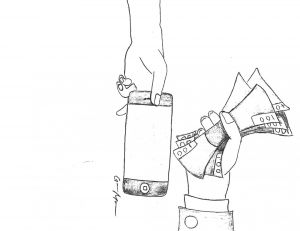It seems like Apple is now able to persuade millions of iPhone users to pay higher than ever before for an upgrade. The world’s most valuable company recently disclosed its biggest and most expensive iPhone lineup to date at the Steve Jobs Theater in Cupertino, California. For years, the event has created large amounts of interest in the tech world, with thousands streaming it online and millions watching videos unveiling the products on YouTube after the show. This year’s keynote brought three new iPhones equipped with faster processors, improved cameras and longer battery life—but to the dismay of many—a higher sticker price. Two of the three iPhones introduced start at $1,000 and up, begging the question: Are new iPhones still worth it?
The smartphone market as a whole is facing its biggest change since the release of the original iPhone back in 2007. Cheaper phones are becoming more advanced, and more advanced phones are becoming cheaper; the iPhone is an exception. Apple has long stood by its strategy of releasing quality products in the high-end marketplace without offering cheaper options. Now, customers are faced with the choice of hundreds of new phones boasting high end features at an affordable price, resulting in the iPhone no longer being a reasonable buying option. The average price for a new 2018 iPhone is about $950.

Meanwhile, other new phones are storming the market, such as the PocoPhone, offering the same features for less than half the cost. The PocoPhone, albeit less popular, starts at an astonishingly low price of $299 with features sometimes outpacing those of the new iPhone XS, such as battery life and processing power. The XS doesn’t seem worth it for more than three times the price of the PocoPhone, when it includes the same features.
With this being said, undermining the quality of Apple’s products is unreasonable. With a glass front and back smoothly sloping into a stainless steel band that holds the device together, the new iPhone is the epitome of quality technology at our fingertips. Even with no new features, the phones have an easy-to-use interface and best-in-class specs, making the new iPhones truly amazing but just not worth it.
Despite obvious and more affordable choices, Apple is still somehow able to convince millions of people to spend more money for an upgrade. With this new cycle of phones, Apple’s ability to persuade users that their devices are worth the higher price is baffling. In previous years, when Apple did not showcase a new iPhone design, it still brought new breakthrough features such as Touch ID, Face ID or the dual camera system. The same cannot be said for this year, as the only new components Apple presented were an array of colors, storage options and screen sizes. The company utilizes effective marketing strategies, claiming that their products are the “most advanced,” “incredible” and “breathtaking,” ultimately making people feel like they are missing out on something new and exciting if they don’t have the newest product.
It’s not just the effective marketing strategies though. People also return to purchase new iPhones because of the environment. IOS, the operating system for Apple phones, provides users with iMessage, iCloud, Apple Music and countless other features specifically designed to be difficult to let go of. Transferring thousands of photos from an iCloud account onto a different operating system is a painstakingly long process. Apple’s services work seamlessly throughout their array of devices, but only their devices. A $400 Apple Watch becomes useless if you switch to an Android, making the process of leaving Apple all the more unappealing. Trapping customers in the environment is disturbing, as companies should make it easier and more user-friendly to switch from their products to those of another company. Apple is also supposed to be leaders of the charge to make smartphones smarter, but they are falling short.
Leading tech companies like Apple are expected to come out with inventive new features only available at a higher price, then have those features trickle down to lower-end models. Nowadays, Apple is doing nothing original, but is still insisting that its new iPhone XS Max is worth $1,100. For those not willing to spend that much, Apple is also offering customers a new device called the iPhone XR with diminished features.
The iPhone XR starts at $750, and Apple is calling it their “budget” model which is nowhere near a budget price compared to other products on the market. The XR has lesser features such as a lower quality camera and the same screen resolution as the iPhone 4 that was released over eight years ago. Screen resolution is one of the cheapest aspects of a phone to mass produce, proving that it would not have cost Apple much more to increase the resolution to a more modern quality, according to smartphone expert and YouTube personality Lewis Hilsenteger. The company has only done this to differentiate its “budget” phone from its high-end ones, prompting customers to feel like they are missing out on something revolutionary if they don’t hand over $1,100.
Apple has forced customers into an uncomfortable position, one where they must put extra thought into whether the phone is really worth it. If people have to think hard about whether it’s worth it or not, it’s probably not.







